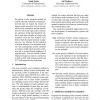Free Online Productivity Tools
i2Speak
i2Symbol
i2OCR
iTex2Img
iWeb2Print
iWeb2Shot
i2Type
iPdf2Split
iPdf2Merge
i2Bopomofo
i2Arabic
i2Style
i2Image
i2PDF
iLatex2Rtf
Sci2ools
EMNLP
2009
2009
Automatically Evaluating Content Selection in Summarization without Human Models
We present a fully automatic method for content selection evaluation in summarization that does not require the creation of human model summaries. Our work capitalizes on the assumption that the distribution of words in the input and an informative summary of that input should be similar to each other. Results on a large scale evaluation from the Text Analysis Conference show that input-summary comparisons are very effective for the evaluation of content selection. Our automatic methods rank participating systems similarly to manual model-based pyramid evaluation and to manual human judgments of responsiveness. The best feature, JensenShannon divergence, leads to a correlation as high as 0.88 with manual pyramid and 0.73 with responsiveness evaluations.
Related Content
| Added | 17 Feb 2011 |
| Updated | 17 Feb 2011 |
| Type | Journal |
| Year | 2009 |
| Where | EMNLP |
| Authors | Annie Louis, Ani Nenkova |
Comments (0)

